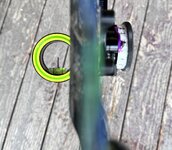If my eyes hadn’t gone South, I would probably still be using the same scope without dials. Western hunting we aren’t sitting in blinds, we have to hoof it. Back in the day before we had fancy dialing optics or range finders actually…no ballistic apps either, we did two things: 1) Use a flat shooting cartridge like a 270 Win….2) Sight in 200-300 yards. Granted, we couldn’t dial because we didn’t have the turrets! Our effective range was limited. At that time It was considered unethical to take a shot beyond 500 yards. Using the same rifle with the same ammo, we learned where the bullet was going to go at any given range.
In my first post I stated that you should be able to make the shot inside of 450 yards without dialing…if you can’t, then you should shoot your rifle more. With the scopes I have now I will usually dial up beyond 350 yards if I think I have the time. Logic would dictate that beyond 500 yards the time to hold (100 yard zero) is probably longer than dialing up. Experienced speed goat hunters will tell you that hurry up shots are more than common. Case in point: Quite often when a herd spooks, they will run off a ways but then the herd buck will often stop to size up the danger for a few seconds. Could be 200 or it could be 400 yards, who knows.
My longest shot on a Pronghorn buck is 465 yards. I found a herd around a tank at sunset. The next morning, I set up on a low rise near where they went in. The herd was right on time but the herd doe walked up near me, snorted and then the herd took off. I put the cross hairs on the herd buck and followed. He stopped, I guessed 400 yards, made the hold, and sent the round. It was a perfect heart shot but I still felt lucky.
In my first post I stated that you should be able to make the shot inside of 450 yards without dialing…if you can’t, then you should shoot your rifle more. With the scopes I have now I will usually dial up beyond 350 yards if I think I have the time. Logic would dictate that beyond 500 yards the time to hold (100 yard zero) is probably longer than dialing up. Experienced speed goat hunters will tell you that hurry up shots are more than common. Case in point: Quite often when a herd spooks, they will run off a ways but then the herd buck will often stop to size up the danger for a few seconds. Could be 200 or it could be 400 yards, who knows.
My longest shot on a Pronghorn buck is 465 yards. I found a herd around a tank at sunset. The next morning, I set up on a low rise near where they went in. The herd was right on time but the herd doe walked up near me, snorted and then the herd took off. I put the cross hairs on the herd buck and followed. He stopped, I guessed 400 yards, made the hold, and sent the round. It was a perfect heart shot but I still felt lucky.
Last edited:

